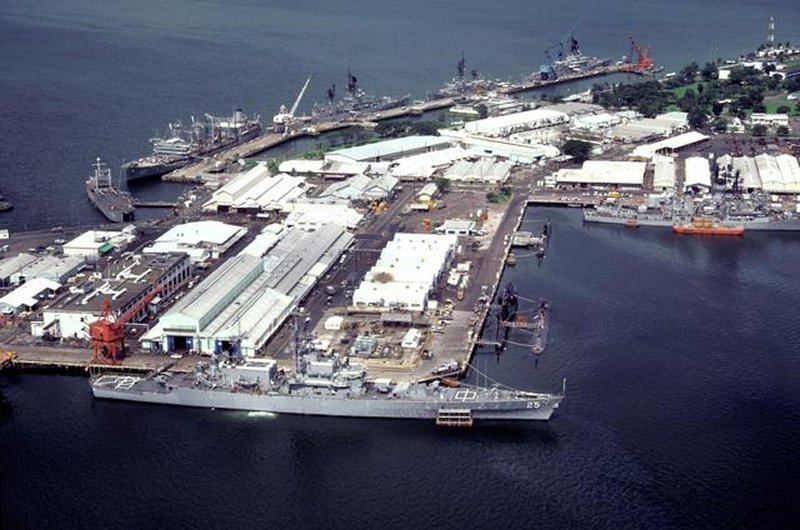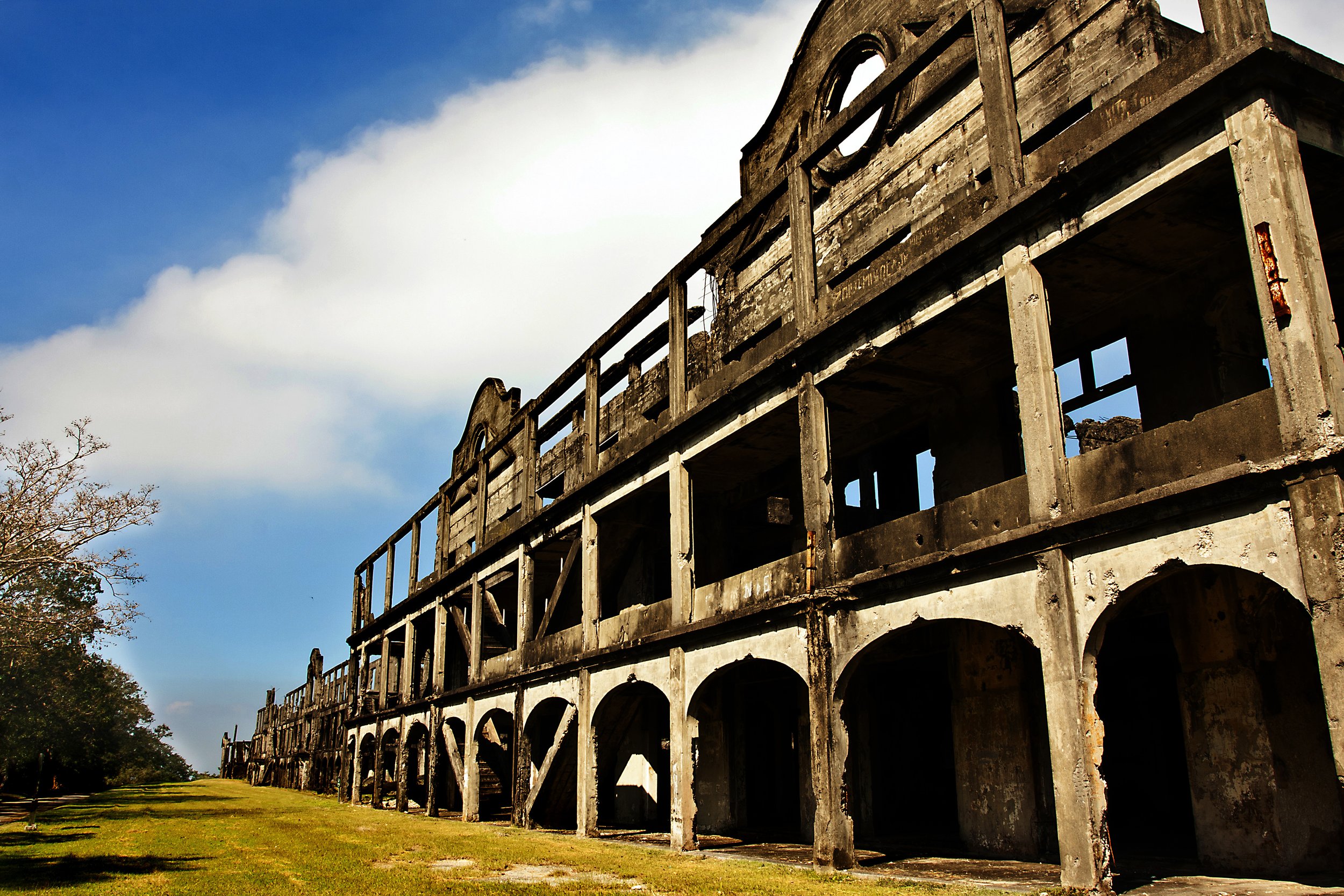War and Remembrance in the Philippines
/After our wedding, I took my American husband on two trips to the Philippines. Not only did I want him to appreciate from where I come, but I also wanted to relive WWII in the Philippines with him by my side.
Subic Naval Base, a major ship-repair, supply, and rest and recreation facility first of the Spanish Navy and then of the US Navy, was the second largest overseas military installation of the US Armed Forces after Clark Air Force Base. Since the turnover of all the bases back to the Philippine government in 1991, it has become the Subic Bay Freeport Zone, a major industrial park, a beloved tourist resort, and a sought-after residential haven.
Subic Naval Base before the turnover in 1992 (Source: globalsecurity.org)
One of my girlfriends (also married to an American) lives there in a beautiful former officer’s home for a low long-term lease. This Freeport Zone has become a tourist destination. The tourist duty-free shops still operate and offer many a bargain, so I did some shopping. The beaches still looked very inviting and my husband did some scuba diving to see the wrecks at the bottom of the bay. The surrounding hills provided opportunities for interesting jungle trips, too. And a high school classmate who still lives in Subic showed me how planeloads of Asians are brought to its casinos for a gambling weekend.
Then we took a trip to Hong Kong and we chose to depart from the Clark International Airport. The bus trip to and from Manila was about 1 1/2 hours long (maybe shorter now), but the fares were cheap. The airport is a major factor in the success of the area now known as the Clark Freeport Zone. Extensive facilities and land are two other factors. Clark Air Force Base was the backbone of logistical support during the Vietnam War. In fact, it was only in Clark where my husband was able to fly a plane at a flying school there. The former military reservation consists of 14.3 square miles and extends farther north for another 230 square miles.
We had a few hours before boarding, so we hired a van to take us around. We discovered a lonely Goddess of Peace Memorial, a gift from Japan, and an empty Expo Center, a former project of President Fidel Ramos, which I believe has since been rehabilitated. It was a drive through the Villages in the surrounding hills that saved our day. Home to the native Aetas, we witnessed a cow being butchered in preparation for a wedding feast that evening.
An Aeta hut off the former Clark Air Base. (Photo by from Carol Colborn)
Coming back from Hong Kong, my girlfriends picked us up from the airport. We stayed in Clark for the night. In the morning, we took the SCTEX, the interchange connecting Subic and Clark, and proceeded to Montemar Beach Resort in Mariveles, Bataan, where one of them is a member. The town is actually where the 60-mile Death March started after the Fall of Bataan. Markers are placed at regular intervals on the road, retracing the infamous route.
A Bataan Death March mile marker (Photo from Carol Colborn)
We must remember that it was on Dec. 7, 1941 when the Japanese sneakily bombed Pearl Harbor. Only four months after, on April 9, 1942, Bataan fell to the Japanese. Seventy-five thousand Filipino and American soldiers were forcibly transferred to the POW camp in Capas, Tarlac on that Death March. The March resulted in very high fatalities inflicted upon prisoners and civilians alike. It was later judged by an Allied military commission to be a Japanese war crime.
On the way to Montemar, we visited the Mt. Samat National Shrine, a 92-meter huge cross accessible via 448 steps near the summit, in the town of Pilar, Bataan. Built as a memorial to all those who suffered in the March, it is said to be made of rocks from Corregidor stained by blood. We also stopped by Acuzar, a town before Mariveles also in Bataan, where Las Casas Filipinas was built as a memorial to Filipino legacy from Spanish times. It has several restored ancestral Filipino homes from around the country brought there piece by piece.
After the Fall of Bataan, the focus of the Japanese campaign shifted to the island of Corregidor at the mouth of Manila Bay with Bataan to its left, Manila in front, and Cavite to the right. This strategic location prompted the Americans to make it an “impregnable fortress.” However, on May 6, 1942, not even a month after Bataan fell, the Fil-Am forces on the island also surrendered, and the Japanese completed its conquest of the Philippines.
On our second trip to the Philippines, to complete the story of WWII there, I took my husband to the island. The voyage on the hydrofoil took just one and a half hours from the Folk Arts Theatre area, part of the reclaimed land on Manila Bay. Colorful replicas of the old trollies called tranvias took us around the island. This became the most emotional part of reliving the war’s story.
The skeletons of heavily bombed buildings were reminders of the gruesome battle that lasted five painful months. The ghost of the longest single military barracks in the world housing 8,000 soldiers called Mile-Long Barracks, stood eerily tragic. The savageness of the war was splashed in the remains of the cross-shaped hospital which the Japanese destroyed despite war treaties making such places safe (shades of the Ukraine children’s hospital).
The Mile-Long Barracks in Corregidor (Source: Wikipedia)
The brave soldiers who defended the Island are celebrated in many monuments: the Pacific War Memorial with its Altar and Eternal Flame; the Filipino Heroes Memorial with 14 murals of Philippine history; and the statue of Gen. Macarthur, who escaped to Australia, famously declaring, “I shall return.” He did. And three years later the island was retaken. Seven months later, the atomic bombs were dropped on Hiroshima and Nagasaki. The Japanese surrendered and WWII ended. Allied victory in Europe had been assured months earlier in Normandy.
The Malinta Tunnel Night Tour is the most descriptive of the life of soldiers on the fortress. It is a 2.5-mile network of laterals on Malinta (full of leeches) Hill. At times while bending low to pass through narrower sub-laterals, we experienced utter darkness. There were whiffs of coolness from air passages. We saw the remnants of the 1,000-bed hospital that replaced the destroyed hospital outside, President Quezon’s and the soldiers’ quarters, and the petroleum storage facilities. We were even able to retrace the escape route of Gen. MacArthur. Somewhere in those dark recesses were also kept the bones of a Japanese soldier.
The entrance to the Malinta Tunnel in Corregidor (Source: Wikimedia)
After the second trip, my husband remarked, “Maybe that’s why I got drawn to you. Filipino-American relations were indeed very close.” It was a great time to tell him the stories of my father who fought with Americans and my mother, then a schoolteacher, who painstakingly learned Japanese to interpret for the Filipino and American soldiers. Taking this trip with my American husband made it doubly significant especially since, right before the second trip, I became an American citizen.
Originally posted on the author’s blog site, this article was reposted in the April 2017 issue of EastLit (https://www.eastlit.com/eastlit-issue-seven/eastlit-june-2013-content/reliving-world-war-ii-in-the-philippines/).
Carol Esguerra Colborn was a former executive in pioneering IT companies in the Philippines before she migrated to the US where she became an adjunct professor at four institutions of higher learning until her marriage to an American businessman. They RVed around North America for eight years then explored 48 countries after that which all led to her blog, Cruising Past 70, three travel books currently available on Amazon, and writing for Travel Awaits twice a month.
More articles from Carol Esguerra Colborn








